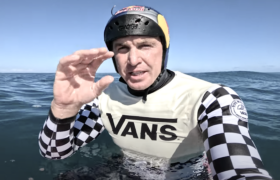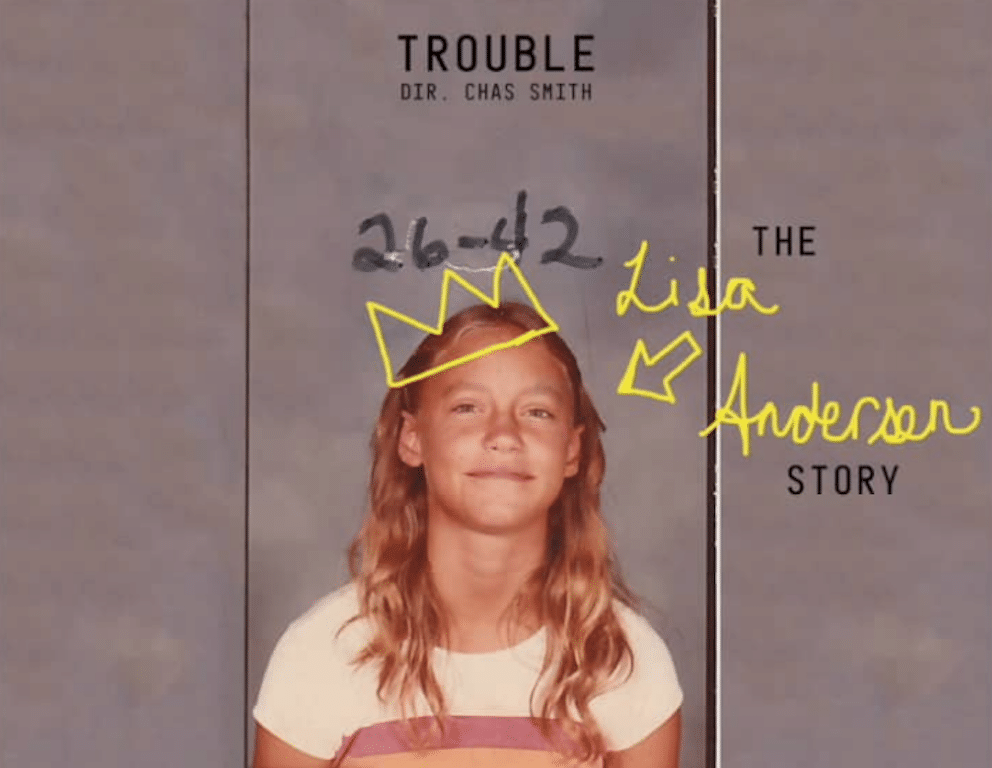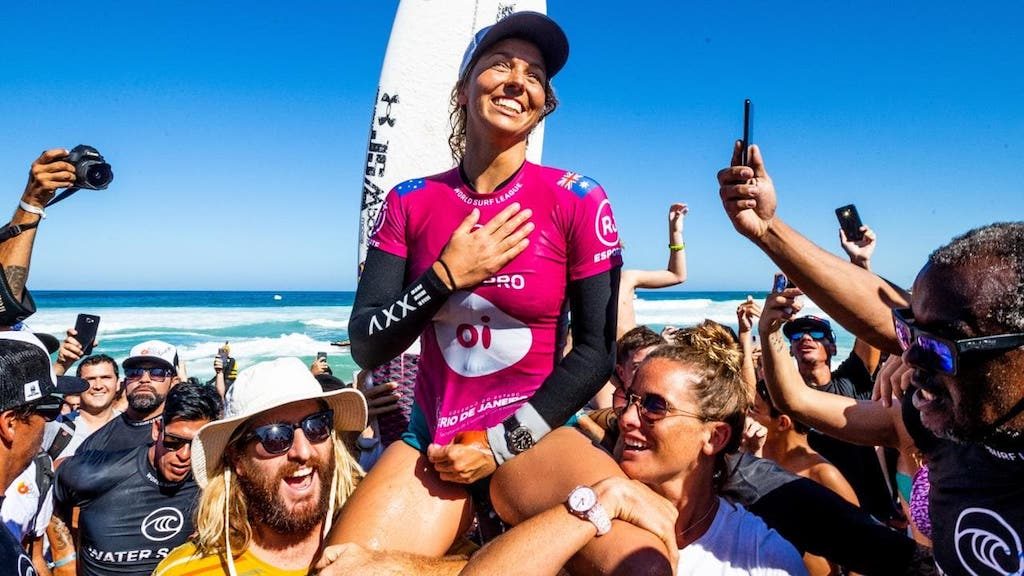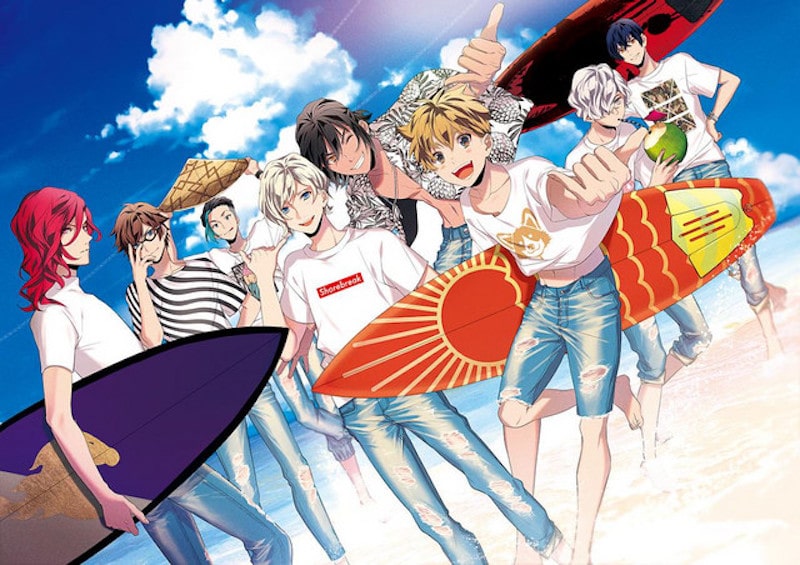In its treatment of the emotional and physical extremes of big-wave surfing and the reality of death this movie transcends its subject matter.
Since humans came out of the trees, or out of the swamps if you believe the aquatic ape theory, as I do, the earliest stories we have told ourselves have been of monsters of the deep.
The first literature we know of: Beowulf, The Epic of Gilgamesh features heroes battling watery monsters. No wonder big-wave surfing, a modern day trope of the ancient theme, where surfers seek a “chilling ecstasy” in waves that can kill, exerts such an arresting influence on filmmakers and audiences alike.
Films about big-wave surfing almost all suffer by succumbing to the irresistible temptation to over play the hand. Waving around fully erect for 90 minutes in a state of over engorged high drama makes for great trailers but terrible films. Heavy Water is a different film altogether.
The latest incarnation Heavy Water, by Sea of Darkness director Mike Oblowitz, examines the nexus of death and big-wave surfing through the deadpan delivery and life arc of Nathan Fletcher.
Films about big-wave surfing almost all suffer by succumbing to the irresistible temptation to over play the hand. Waving around fully erect for 90 minutes in a state of over engorged high drama makes for great trailers but terrible films.
Heavy Water is a different film altogether. Eschewing the constant drama it spends most of it’s time building and maintaining an atmosphere of claustrophobic dread.
In its treatment of the emotional and physical extremes of big-wave surfing and the reality of death it transcends its subject matter.
The greatest film about surfing ever made, I think. Please allow me to persuade.
Leathered ancient Woody Brown sets the emotional tone of the film in the opening montage.
“I loved to challenge death,” he claims, with the resulting thrill giving his life a frisson the unjazzed could never comprehend.
Nathan is introduced. We are all familiar with the broad narrative arc: son of Herbie Fletcher, brother of Christian, grandson to big-wave pioneers Flippy Hoffman etc. In a sense, it was a risk to hear Nathan speak. In doing so the danger was the mystique that surrounds him would be gone and gone for good.
A man of few words might be concealing anything, or nothing at all.
Thankfully, in Nate Fletchers case it’s a whole heap of the former.
Despite the advantages of the groomed industry upbringing Fletcher found his own path pretty quickly and it was radical. Falling into the orbit of surf/skate/punk icon Jay Adams shit got very loose, very quickly. The opening stanza of the film explores the influences of a radical California skate/punk culture that no longer exists. Its tentacles extended outwards across the Indo-Pacific.
Like every other cat my first OS trip was Bali.
Lacking a budget we crashed in the Ulu’s warungs, which you could do for free if you could handle rats, monkeys and lying on bamboo mats. I met Jay Adams and Owl Chapman and that’s what I thought surfing was: mushroom milkshakes, airs at low-tide Racetrack and Team Pain tattooed on a neck.
Jay had scary, don’t-give-a-fuck eyes and an unbelievable intensity which flies out of the screen in a scene where Nathan interviews him on home video. The film mostly skirts the darkness of Jay Adams. The next time I saw him was in the tenements of Sunset Vistas on Sunset Point. Jay busted through the door one night, as naked as the day he was born, hid in the bathroom for hours while men with baseball bats roamed the neighborhood, then slid into the surf and swam to safety somewhere. A dangerous friend.
His wasn’t the only radical friendship cultivated by Fletcher. He got cosy with the Irons Brothers at Pipeline. A mutual admiration developed. A kinship with Bruce had parallels with overbearing and aggressive older brothers, Andy gave Bruce hell and although it’s never explicitly stated in the film the presence of Christian in Nathan’s life has a hard edge to it that no editing can hide.
Things came to head on a pre-millennial trip to the Mentawais which coincided with Andy’s 21st Birthday. Andy tried to drink with Matt Archbold, a very unwise move according to Christian. He stopped breathing, poisoned. It was Nathan who found him and brought him back to life.
Life-and-death friendships and a calm intensity in heavy water dominate the second half the film as a sense of inevitability settles on the film. People seemed marked for death, or greatness, or both in the case of AI.
A delicious irony propels the narrative. Despite the Laird/Kalama team bathing in the glory of the tow-in revolution it was Nathan’s father Herbie who pioneered the use of power in the surf zone with jetskis at Pipeline. And it was Nathan who swung the pendulum back to paddle surfing in giant surf on the outer reefs of the North Shore. Phantoms, Himalayas, Outside Alligators, all tamed by Fletcher and pals on dedicated sleds built to get in early in thirty-foot-plus surf.
I fell head over heels for the film at this point.
Hollywood would have ran straight ahead to the tragedy of Sion Milosky’s death at Mavericks and Nathan’s redemption waves at Cloudbreak and Teahupoo but Oblowitz detours left, into surfboard design. We meet a barrel-chested, long-haired barefoot shaper, Leroy Dennis, and the story of eleven and twelve-foot surfboards.
History and lineage flow through into the present. The Buzzy Trent outline, the Brewer rail profile. Combined with Nathans re-introduction of the four fin it illuminated a feature of his big wave paddle-ins. He gets in earlier, cleaner and cuts a deeper, purer line from a more forwards stance than any other big waver. It’s something never mentioned but it becomes obvious in the film.
From outer reefs to Mavericks, to the left at Jaws, Nate gets in better than anyone.
How do people survive giant surf? The answer is, they don’t always.
The death toll slowly ticks over. Year on year. Mavericks surfer Grant Washburn reminds us that you are pushing up against human limits and it’s not a case of mind over matter. Shit goes wrong, people die. Fletcher’s strategy for survival is one of limited exposure. It’s the same one used by American author Jim Harrison as outlined in his obit in the NY times.
In this case, it applies to eating but it makes more sense when considering giant surf.
“The idea,” Mr. Harrison wrote, “is to eat well and not die from it — for the simple reason that that would be the end of your eating.”
We all know Sion Milosky drowned at Mavericks. The details make for some of the most powerful and moving cinema ever made about surfing. Nathan had done the business and got out, limited exposure, Sion was on a roll and wanted to charge on.
Fletcher heads back to the harbour to drop off Danny Fuller and comes back out with a new board. In late afternoon fall light, and to Fletcher ‘s incredulity, Sion is gone. A panicked search ensues. Milosky is found face down still attached to his board floating around the inside rocks.
Cold and dead.
A victim of the limits of human experience being violated one too many times and what Fletcher described chillingly as a failure by skis in the line-up to account for “inventory.”
I’d always wondered about the timeline of that year. Fate brought me into contact with Nathan at the high point of his big-wave journey. We crossed paths on the small bridge at Teahupoo on the morning of the Code Red swell in Tahiti before he entered the water.
A few hours later, I witnessed first hand and close-up the infamous Teahupoo monster he rode and that could have easily claimed him, like Mavs did Sion.
Sion died March 16, 2011. July 12 Nathan paddled an extra perfect massive wave at Cloudbreak on a pink ten-footer. August 27 he got the Code Red Teahupoo wave.
That’s a gnarly few months in any estimation.
What is obvious from Heavy Water is that Nathan Fletcher is a man whose inner and outer worlds exist in a strange kind of asynchrony. When I met him on the bridge at Teahupoo he seemed almost preternaturally calm and composed. He describes the mission as being disorganised and his internal state as a nervous wreck. Chaos was the dominant theme that day at Teahupoo.
It seemed inevitable human beings would be crushed under the weight of mountains of deformed bacterial-green ocean.
Gendarmes prevented boats leaving the harbour. It was after midday when I finally snuck aboard a vessel after a whole lot of hustle. The lagoon was heaving with current like a tsunami. The first wave I saw was a Bruce Irons beast that ripped his shorts off.
Within minutes, Nathan was being whipped in.
Memories are unreliable, I recall something so dark as to be subterranean, the footage shows a wan sunlight illuminating the wave. I remember screaming, horrified screaming, but that might have been my internal monologue. Even today, I have no words to describe it, except for deeply terrifying. My stomach felt full of ice cold gravel.
As the moment of impact became inescapable Nathan submitted to fate, “Oh well I’ve had a great life, humans just don’t handle this”.
But he did. He came back.
The film could have ended there. But as a coda to a life of extreme wave chasing Nathan planned a stunt to acid drop a white crested boomer from a chopper.
“This has to be lame,” I thought. A lame, Hollywood gimmick.
It is not lame.
It is so fucking good.
I loved this sequence so much.
It is so well shot, so masterfully edited with so much flow with a soundtrack that paws along underneath like a caged beast pacing in a cage.
When Darrick Doerner made a cameo as safety officer in blue camo I was in ecstasy. No spoilers. Some will see it as a stunt.
I say, appreciate it on it’s merits, as a masterpiece of filmmaking.
I watched Oblowitz’s Sea of Darkness anchored up off Sipora. The dream of “60 feet on the waterline” affected everyone who viewed.
This film, which explores why we do what we do, who we are and how the granite strata of fate traps us all, is better.
The best surf film ever made. I urge you to see it, in the strongest possible terms.
Heavy Water opens in 150 cinemas across Australia tomorrow (June 26); UK Tour Dates here.
USA cinema release to come.







